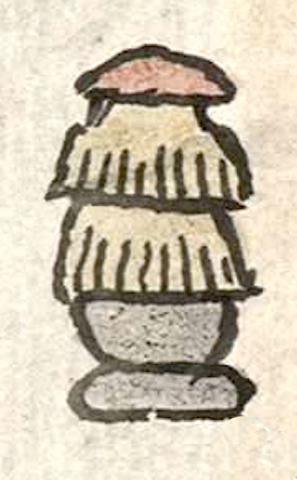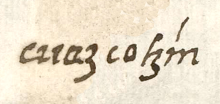Cuezcontzin (CmpRG)
This is a simplex glyph for the personal name Cuezcontzin (“Grain Silo,” attested here as a man's name). The glyph shows an Indigenous-style grain silo (cuezcomatl). The gloss in the source, the Relación Geográfica de Cempoala (originally Cempohuallan, and now Zempoala, Hidalgo), drops off the -ma- element of the noun and also inadvertently leaves off the "n" at the end of the name, which could be there as a substitute for the "m," so we have supplied it. The honorific suffix -tzin is not visualized. The cuezcomatl is outlined in black and is presented in a frontal view. It has a red cap, below which are two tiers of thatched material in tan, resting on a base shaded in grey.
Robert Haskett
There is an hacienda in the state of Tlaxcala called "La Cuezcontzin," which justifies our alteration of the gloss for this man's name. [See: Guadalupe de la Torre Villalpando, Las calpanerías de las haciendas tlaxcaltecas, 1988.] This simplex glyph is one of three such elements that serve to name an individual pictured on the map (a fourth person wearing similar attire lacks an alphabetic gloss and is not clearly linked to a glyph naming him, though there are two possibilities nearby). All three of the men with glyphic names are dressed in what seem to be pelts of some kind (see the historical contextualizing image). This suggests that they are figures from the far past or, as posited by Barbara Mundy, they are Otomies rather than Nahuas (the Spanish text of the Relación states that Otomi peoples did live in the area). Other figures are glossed with alphabetically rendered names in Spanish, most of them bearing the title “don” preceding their “Christian” name, such as “don Francisco,” but lacking a surname. Many of these men that are named only with alphabetic glosses are seated on icpalli, the woven seat or “throne” indicating noble status. These men wear what appear to be elite white cotton garments and have traditional diadems (xiuhhuitzolli) on their heads. In the present case, who Cuezcontzin was, and why he is featured so prominently on the map, does not seem to be explained in the Spanish text of the Relación. However, if not Otomies, he and the other three similar figures may be the kind of people referred to in the answer to item number 13, “lo que quiere decir en lengua de indios del dicho pueblo [etc.]” (fol. 1v; “what the [name] of the said pueblo means in the language of the Indians”). Speaking of the language of the people who settled and live in the area, the text notes that they included those who speak Nahuatl (“la lengua mexicana”) and that there are “algunos chichimecos que quere decir gente barbara” (“some Chichimecos, which means ‘barbarians’”). Whatever the case, Cuezcontzin is situated below another, similar figure glossed as Acapa. Both of them are seen not too far below the lower left edge of the large place glyph for Cempohuallan. For a study of the RG (which, however, does not mention these particular figures), see Mundy, Barbara E., “Mapping Babel: A Sixteenth-Century Indigenous Map from Mexico,” The Appendix, 1:4 (October 2013), https://theappendix.net/issues/2013/10/mapping-babel-a-sixteenth-century.... Mundy (1996), 132, analyzes and discusses Cuezcontzin and the other three similar figures, and see also Ballesteros García (2005), 79.
Robert Haskett
cuazcotzin
Cuezcontzin
Robert Haskett
1580
Robert Haskett
personal name, grain silo, corncrib, grain bin, cuezcomate
This cuezcomatl is located in Atlatlaucan (probably originally Atlatlauhcan), Morelos. This corn storage container still shows thatching, and perhaps it once had a higher layer of thatch at the top, as suggested by the glyph above. This granary appears to be made with clay/adobe. It was photographed by Robert Jackson, 27 July 2022.

cuezcoma(tl), grain silo, grain storage bin, corncrib, https://nahuatl.wired-humanities.org/content/cuezcomatl
-tzin(tli), honorific or diminutive, https://nahuatl.wired-humanities.org/content/tzintli-0
cuezcomate
Robert Haskett
Relación de Cempoala - University of Texas Libraries Collections. 1580-11-01. https://collections.lib.utexas.edu/catalog/utblac:f87917e2-e3c9-4eb2-a83...
Materials that are in the public domain (such as most of the maps in the PCL Map Collection) are not copyrighted, and no permission is needed to copy them. You may download them and use them as you wish. The image appears here courtesy of the University of Texas Libraries, The University of Texas at Austin. If you do publish anything from this database, please cite the Visual Lexicon of Aztec Hieroglyphs.





